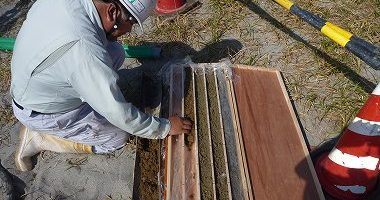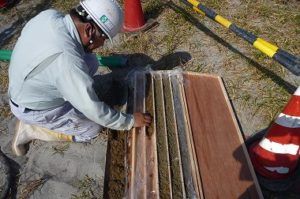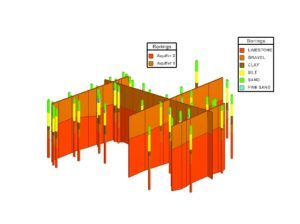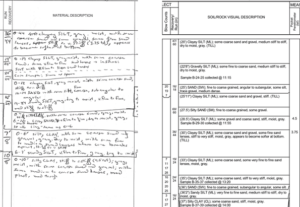Digitizing Dirt: Technology-Induced Excitement for Soil Borings

Digital products allow geologists to significantly reduce the time and cost of logging soil borings, but with yet-to-be-resolved industry challenges.
In the environmental investigation and remediation industry, soil borings are commonly drilled to collect soil and groundwater samples for laboratory analysis to detect chemical contamination. Borings are also drilled to install groundwater monitoring and/or remediation wells. While the physical drilling is conducted by contracted drilling companies, the oversight and data interpretation is often conducted by environmental technical consulting companies.

A consulting geologist will visually and tactilely inspect soil samples in real time as they are being extracted from the ground. The geologist identifies and documents the stratigraphy of the ground formation for use in mapping the vertical geology of the site, which can be used to make strategic decisions on groundwater well design, further investigation, and the design of remediation solutions.1,2

Geologists drilling wells for environmental investigation have historically logged the geology of the well borings in hard copy, hand-written field log books. These log books served the dual purpose of acting as a weatherproof medium to take notes, as well a legal documentation of the activities and observations on site, a critical function given that contaminated properties can often become involved in litigation. In the last few decades, industry-specific software has developed that allows geologists to digitize their hand-written notes once back in the office and create digital boring logs for future reference and to include in reports required by clients and regulators.3,4 This process typically entails a drafter in the office reviewing the geologist’s logbook, inputting the hand-written notes into the software program, a review and redline by the geologist for accuracy (which is often low due to poor field hand-writing and note-taking), corrections, and additional iterations as needed. This results in a time-consuming, expensive effort in the office for every boring drilled in the field.

http://www.enviroinsite.com/feature-geology.html
Companies such as LogitEasy have developed software that enable geologists to now use digital equipment (such as tablets) to create their logs in real-time in the field.3,4,5 In addition to digital data input (their free boring log software offering), LogitEasy also offers data entry directly to the cloud (premium software), and boring log and AutoCAD drafting services. Digitally inputting logging data has the benefits of 1) reducing the effort of digitization back in the office (a significant labor time savings), 2) allowing managers in the office to view data in real-time with cloud computing, thereby allowing for remote game-time decisions on well placements, and 3) increasing the accuracy of logs due to the reduced touch points of the data. Additionally, with mobile data enabled tablets or laptops, entering data directly to the cloud protects against data loss. However, geologists have been slow to embrace this change due to the concerns of potential data loss due to user or technology error (extremely costly since borings can be upward of $10K to re-drill depending on depth and accessibility), regulatory requirements for physical logbooks, potential user error in inputting data on a digital interface, and data privacy concerns and/or contractual requirements passed on by their clients.

An additional development step companies like LogitEasy could consider would be to have an interface that can record and transcribe handwriting, so that data can be handwritten (an input that is less likely to be erroneous that key-entered data) and act as a back-up to the digital interpretation if there are dubious results. Further, these companies could pursue partnerships with regulatory agencies: with compatible formats, digital logs could be used by regulators to map stratigraphy at a regional level, allowing for better geological and environmental contaminant and transport understanding. Regulatory acceptance and support can help spur industry acceptance and incorporation. Finally, LogitEasy could evaluate the feasibility of developing a data management solution that would allow users to connect directly to their company’s cloud computing, removing LogitEasy from the responsibility of managing and protecting client data, as well as helping clients comply with their contractual data management requirements.
(638 words)
References:
- California Environmental Protection Agency. 1995. Drilling, Coring, Sampling and Logging at Hazardous Substance Release Sites. [ONLINE] Available at: http://www.dtsc.ca.gov/SiteCleanup/upload/SMP_Drilling_Coring_Sampling_Logging.pdf. [Accessed 16 November 2016].
- Department of Toxic Substances Control. 2001. Guidance Document Monitoring Requirements for Permitted Hazardous Waste Facilities . [ONLINE] Available at: http://www.dtsc.ca.gov/hazardouswaste/upload/hwmp_guidance_monitoring-requirements.pdf. [Accessed 16 November 2016].
- 2016. Boring Logs. Exciting Possibilities!. [ONLINE] Available at: https://logiteasy.com/. [Accessed 16 November 2016].
- M-Tech Software. 2016. M-Tech Software. [ONLINE] Available at: http://mtechsoftware.com/default.asp. [Accessed 17 November 2016].
- 2016. pLog Tablet. [ONLINE] Available at: https://www.rockware.com/product/overview.php?id=113. [Accessed 17 November 2016].



Technology and information such as this is extremely important to not only this field but many other technical fields. In my previous engineering days, alot of designs are performed electronically, however when doing reviews in the field, printed versions of the document/drawings are used and if any differences are detected, they are marked up in the field. Having technology such as tablets in the field to process this data, make notes and corrections is crucial and speeds up the entire process thus making it more efficient. Right now, this is an untapped market that needs this type of technology implemented, however changing the culture around this technology may be tougher than we think.